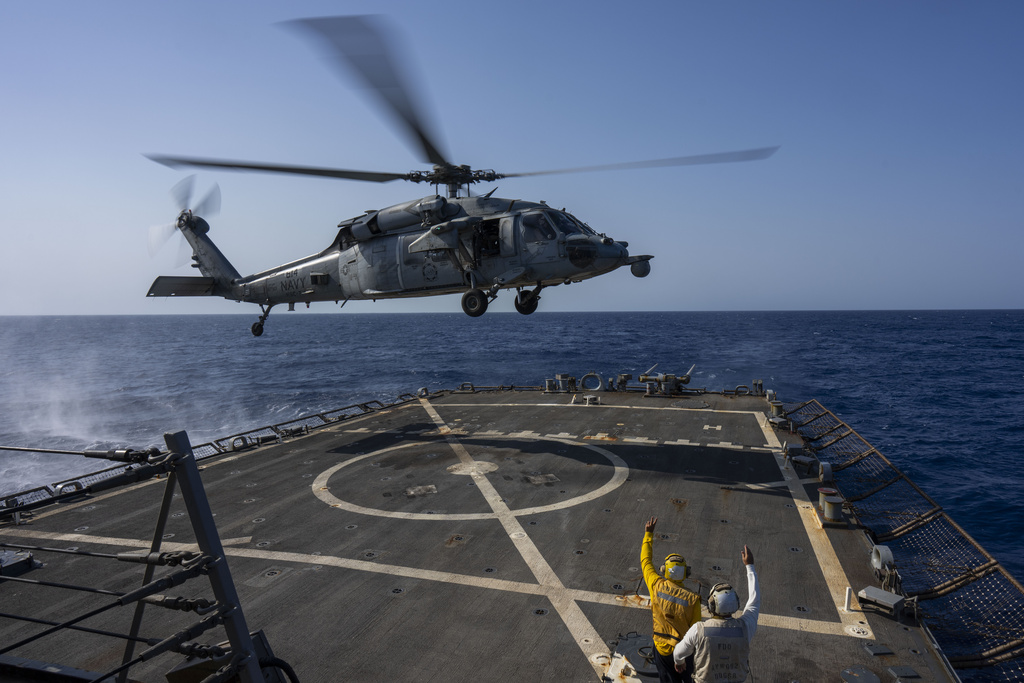U.S. Military Presence in the Middle East Amid Rising Tensions \ Newslooks \ Washington DC \ Mary Sidiqi \ Evening Edition \ The U.S. maintains a heightened military presence in the Middle East, with approximately 40,000 troops, warships, and fighter jets stationed throughout the region to defend allies and deter threats. As tensions rise between Israel and Hezbollah, the U.S. military remains on alert but has not yet increased troop levels. The force is designed to support operations against groups like ISIS and counter Iranian-backed forces in areas like Yemen and Lebanon.

U.S. Military Presence in the Middle East: Quick Looks
- Troops and Forces: The U.S. currently has about 40,000 troops spread across the Middle East, with a spike earlier this year when the force reached nearly 50,000.
- Conflict Areas: The U.S. is involved in multiple conflict zones, including operations against ISIS in Iraq and Syria, as well as defending Israel and countering Iranian-backed threats from Hezbollah and Houthi rebels.
- Warships: The U.S. Navy has warships stationed in the Gulf of Oman, the Red Sea, and the eastern Mediterranean Sea, including aircraft carriers and destroyers.
- Aircraft: The Air Force has four squadrons of fighter jets in the region, including F-22 Raptors, F-15E Strike Eagles, and A-10 Thunderbolt IIs, plus additional jets deployed from the USS Abraham Lincoln.
- Current Situation: Despite the escalating Israel-Hezbollah conflict, the U.S. has not signaled a need for additional troop deployments, relying on its robust existing presence in the region to maintain stability.
Deep Look:
The U.S. military has kept a significant presence in the Middle East over the past year, with approximately 40,000 troops, warships, and fighter jets stationed throughout the region. This force is positioned to defend U.S. allies, including Israel, and act as a deterrent against threats posed by Iran and Iranian-backed groups such as Hezbollah and the Houthis in Yemen. Despite a surge in attacks between Israel and Hezbollah, the U.S. has so far refrained from increasing troop levels, opting instead to rely on its already substantial resources to manage the rising tensions.
Troop Deployment and Presence
Normally, U.S. Central Command oversees around 34,000 troops deployed across the Middle East. However, in response to escalating tensions in the region — particularly after the start of the Israel-Hamas war in Gaza — the number of U.S. forces increased to approximately 40,000. At its peak, that number swelled to nearly 50,000 when U.S. Defense Secretary Lloyd Austin ordered two aircraft carriers and their accompanying warships into the region. These additional deployments aimed to prevent the conflict between Israel and Hezbollah from spilling over into a broader regional war.
Although one of the aircraft carrier strike groups has since moved on to the Asia-Pacific, the heightened U.S. presence remains strong, with assets deployed strategically across the region to safeguard both U.S. and allied personnel. U.S. forces are not only tasked with protecting Israel but are also involved in various other operations, including efforts to suppress the Islamic State group in Iraq and Syria, and counter threats from Iranian-backed Houthi rebels in Yemen.
Navy Warships
The U.S. Navy’s fleet in the Middle East is critical to maintaining stability in the region. Currently, the USS Abraham Lincoln aircraft carrier and its three destroyers are stationed in the Gulf of Oman. Two additional U.S. destroyers are patrolling the Red Sea, helping counter Houthi missile threats aimed at commercial shipping and other targets. Another formidable presence in the region is the USS Georgia, a guided-missile submarine that operates within U.S. Central Command, although its specific location has not been disclosed.
In the eastern Mediterranean, six U.S. warships, including the USS Wasp, an amphibious assault ship carrying the 26th Marine Expeditionary Unit, are positioned to respond quickly to any threats. These ships provide essential air and sea support and can deliver a rapid response to escalating situations, whether in Israel, Lebanon, or beyond.
In times of heightened tensions, American military commanders often rely on the visible presence of aircraft carriers to act as a deterrent. The aircraft carrier brings with it a wide array of fighter jets, surveillance capabilities, and missile systems that serve as a strong warning to adversaries, particularly Iran.
Air Force Fighter Jets
In addition to the Navy’s aircraft carrier-based fighter jets, the U.S. Air Force has stationed four land-based fighter squadrons in the region, including F-22 Raptors, F-15E Strike Eagles, and A-10 Thunderbolt II ground-attack aircraft. Last month, the Air Force added an additional squadron of advanced F-22 fighter jets to the area, enhancing the U.S. military’s ability to suppress enemy air defenses and carry out electronic attacks.
These land-based squadrons are positioned to respond swiftly to any potential attacks or threats from Hezbollah or other hostile actors in the region. The F-22 Raptors, in particular, are known for their stealth capabilities, allowing U.S. forces to carry out missions undetected. The jets can also act as “quarterbacks” in complex operations, coordinating other aircraft and combat missions.
The strategic positioning of these fighter jets gives the U.S. the flexibility to respond to a range of threats, whether it be missile launches from Hezbollah or air strikes against ISIS targets in Iraq and Syria. Moreover, the deployment of these fighter jets sends a strong message to Iran and its proxies that any aggressive actions will be met with a swift and decisive response.
Recent History and Escalations
The current U.S. military posture in the Middle East is a direct result of growing concerns about an all-out war breaking out between Israel and Hezbollah. As Hezbollah ramps up its missile strikes following Israel’s attacks on its communications infrastructure, the U.S. remains deeply invested in preventing the conflict from spreading. The war began on October 7 when Hamas launched a surprise attack on Israel from Gaza, triggering a massive military response from Tel Aviv and drawing Hezbollah into the fray on Israel’s northern front with Lebanon.
Although Israel is managing its nearly yearlong campaign against Hamas, Israeli Defense Minister Yoav Gallant has declared a “new phase” of the war, shifting focus to the northern front against Hezbollah. This change in strategy has raised concerns that the conflict could spread across the region, involving other Iranian-backed militias in Iraq, Syria, and Yemen.
Despite the increase in missile exchanges between Israel and Hezbollah, the U.S. has not yet signaled a troop increase or change in its current posture. However, the existing military presence is robust and ready to defend U.S. allies in the region, counter potential Iranian threats, and protect commercial interests such as shipping routes in the Red Sea.
U.S. Operations Beyond Israel-Hezbollah Conflict
In addition to monitoring the conflict between Israel and Hezbollah, the U.S. military is engaged in several other operations across the Middle East. A significant focus remains on combating remnants of the Islamic State group in Iraq and Syria. The U.S. military frequently conducts air strikes and operations to dismantle ISIS networks and protect allied forces in the region.
Another ongoing threat comes from the Houthi rebels in Yemen, who are backed by Iran. The Houthis have targeted commercial ships in the Red Sea and launched ballistic missiles toward Israel, further escalating tensions. The U.S. military’s presence in the Red Sea and the Gulf of Oman is critical to protecting vital shipping lanes and countering these missile threats.
While the U.S. has relied heavily on its land-based fighter jets to carry out these operations, it has also demonstrated that it can project power from long distances. In February, for instance, two B-1 bombers took off from Dyess Air Force Base in Texas and conducted a 30-hour roundtrip mission to strike 85 Islamic Revolutionary Guards Corps (IRGC) targets in Iraq and Syria, following an attack by IRGC-backed militias that killed three U.S. service members.
U.S.-Military-Presence







